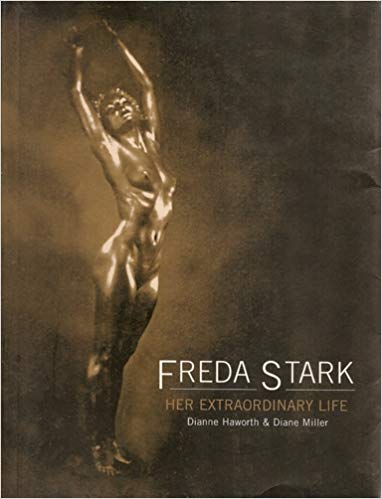BURIED TOGETHER
Partner Thelma Mareo, buried together
Queer Places:
Waikumete Cemetery & Crematorium, 4128 Great North Rd, Glen Eden, Auckland 0602, Nuova Zelanda
 Freda Beatrice Stark (27 March 1910 – 19 March 1999) was a New Zealand
dancer, and a prosecution witness after the prescription drug overdose of
her lover, Thelma Mareo, in 1935. During the Second World War, she was a
famed exotic dancer at Auckland's Wintergarden cabaret and nightclub, and
a favourite of American troops stationed there, where she earned the title
"Fever of the Fleet."
Freda Beatrice Stark (27 March 1910 – 19 March 1999) was a New Zealand
dancer, and a prosecution witness after the prescription drug overdose of
her lover, Thelma Mareo, in 1935. During the Second World War, she was a
famed exotic dancer at Auckland's Wintergarden cabaret and nightclub, and
a favourite of American troops stationed there, where she earned the title
"Fever of the Fleet."
Born in Kaeo in 1910, Stark was the daughter of James Stark, a
shopkeeper, and Isabella Bramley. She attended St Benedict's School and
Epsom Girls Grammar School after her parents shifted to Auckland shortly
after her birth. Her father encouraged her to learn dance, and she began
to do so at nine years of age.
After leaving school, Stark worked as a clerical worker by day, and
danced as "L'Etoile" during the evenings, and her repertoire included tap,
high kicks, tumbles and hula. During the 1930s, she also learned classical
ballet, as steps toward an advanced examination certificate at New
Zealand's Academy of Dance, which she acquired in the late thirties.
In 1933, Stark joined Ernest Rolls' revue, and met a young dancer named
Thelma Trott, and the two women fell in
love. In 1934, Stark was in the chorus of the Duchess of Danitz,, while Trott starred. At this time, Trott married
Eric Mareo, their conductor. The relationship was cut short in 1935 when
Trott took a fatal overdose of the prescription drug Veronal in
unexplained circumstances, leading to Mareo being charged with her murder.
Mareo was tried twice for the murder of Trott, was twice found guilty,
and was twice sentenced to death by hanging (later commuted to 12 years in
prison).[1]
SStark was a prosecution witness at both trials and had to endure being
outed as a lesbian,[2]
and constant subsequent accusations that she had given either mistaken or
selective testimony while under oath which were never proven either way.
Nude photographs of Stark were reproduced during the trial, but Stark
remained unperturbed, and was later described as a model Crown witness.
DDuring the Second World War, Stark was a clerical worker at the
Colonial Ammunition Company during the day. At night, she entertained New
Zealand and American troops at the Wintergarden cabaret and nightclub. At
times, she was clad only in a feather headdress, a G-string and gold
bodypaint. The appreciative American Expeditionary troops bestowed the
title "Fever of the Fleet" on Stark, and often booked out the Wintergarden
specifically to attend her performances, hiring an accompanying band and
floorshow at the same time.
After the Second World War, Stark relocated to London, where she met
and married Harold Robinson, a New Zealand-born dancer (and himself a gay
man) at Sadler's Wells. The duo starred together in New Zealand-born
Robert Steele's art film, Curves and Contrasts (1947), before
their marriage ended by mutual consent. They did not divorce until 1973
and remained close friends.[3]
Although based in the United Kingdom, Stark frequently revisited New
Zealand, before she returned permanently in 1970, and became a secretary
at the University of Auckland.
During the 1990s there was renewed interest in her days as a dancer,
and her life was celebrated in a biography Freda Stark: Her
Extraordinary Life and in Peter Wells and Stewart Mains' documentary,
The Mighty Civic (1989). Stark died
in the Abbey Heights Rest Home in Massey, Auckland, in March 1999. She is
buried alongside Thelma Mareo (1906 – April 15, 1935) at Waikumete
Cemetery, Glen Eden, Auckland, New Zealand.
My published books:


BACK TO HOME PAGE

-
Waikato Law Review report of Mareo trials/a>
-
Pitts, Virginia (30
December 2004),
"Homophobia has no place in tale of fatal love triangle",
The New Zealand Herald,
retrieved 22 September 2007
-
Benson, Nigel (28 June
2008),
"Dancing with the stars",
Otago Daily Times,
retrieved 28 June 2008
 Freda Beatrice Stark (27 March 1910 – 19 March 1999) was a New Zealand
dancer, and a prosecution witness after the prescription drug overdose of
her lover, Thelma Mareo, in 1935. During the Second World War, she was a
famed exotic dancer at Auckland's Wintergarden cabaret and nightclub, and
a favourite of American troops stationed there, where she earned the title
"Fever of the Fleet."
Freda Beatrice Stark (27 March 1910 – 19 March 1999) was a New Zealand
dancer, and a prosecution witness after the prescription drug overdose of
her lover, Thelma Mareo, in 1935. During the Second World War, she was a
famed exotic dancer at Auckland's Wintergarden cabaret and nightclub, and
a favourite of American troops stationed there, where she earned the title
"Fever of the Fleet."
